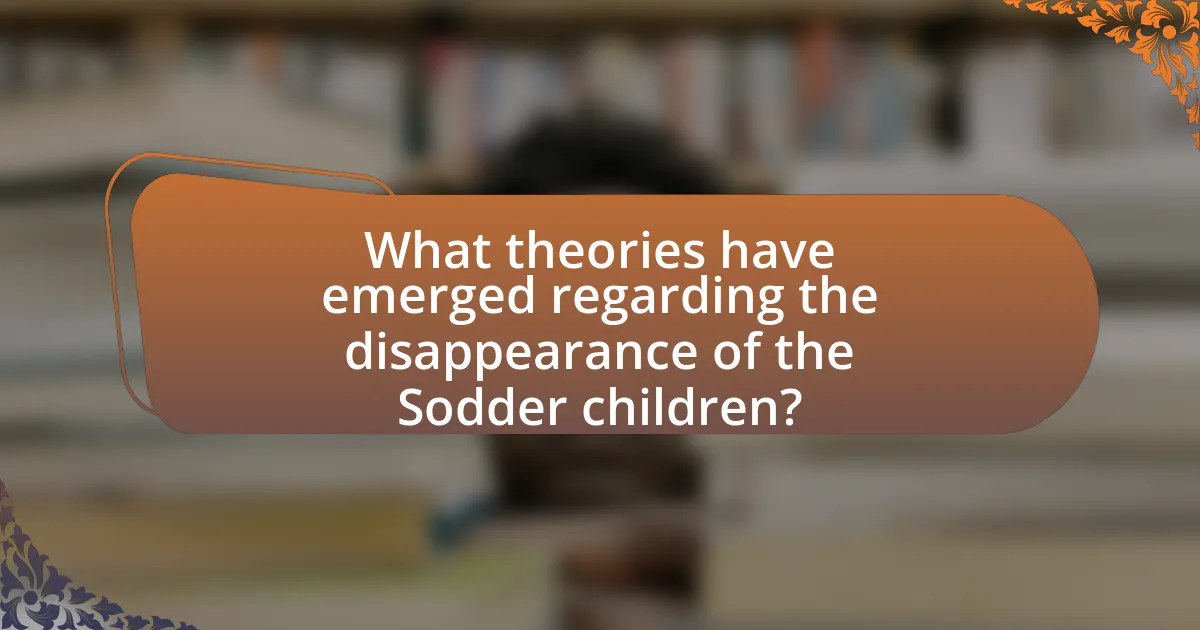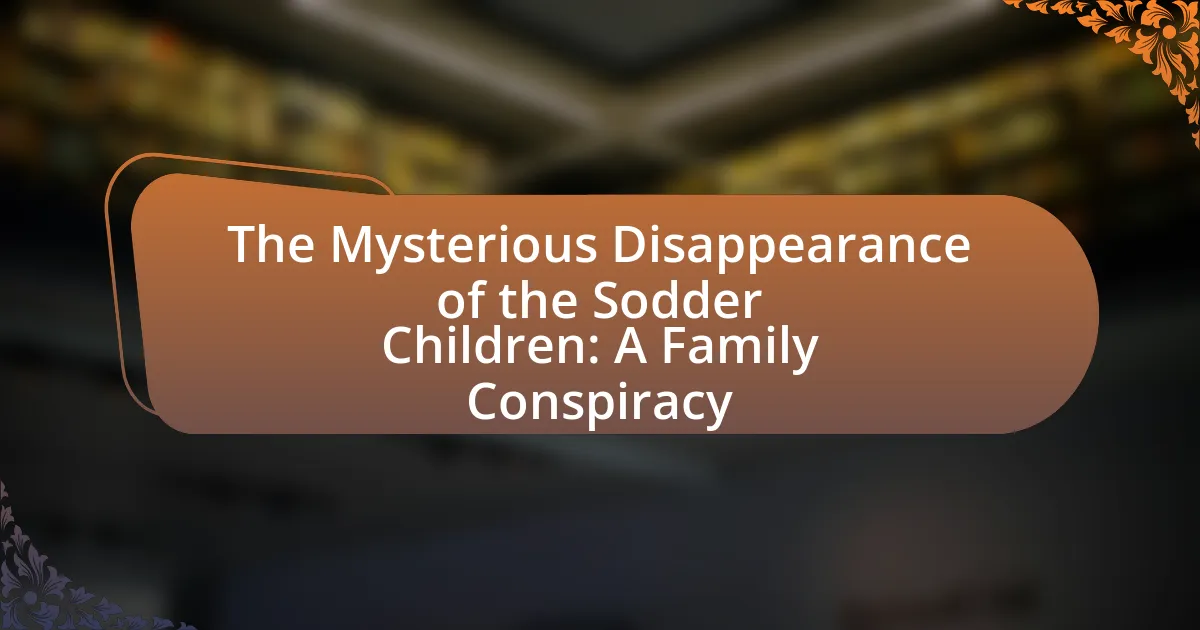The article examines the mysterious disappearance of the Sodder children, who were believed to have died in a house fire on December 24, 1945, in Fayetteville, West Virginia. Despite the fire’s devastation, no remains were found, leading to speculation about their survival and potential abduction. The piece explores the fire’s origins, eyewitness accounts, the family’s immediate reactions, and the subsequent investigation by local authorities. It also delves into various theories surrounding the children’s fate, including kidnapping motives and the impact of the family’s Italian heritage on public perception. Additionally, the article highlights ongoing interest in the case, recent evidence, and lessons learned from the Sodder family’s experience.

What happened to the Sodder children on that fateful night?
On the night of December 24, 1945, the Sodder children were believed to have perished in a house fire that destroyed their family’s home in Fayetteville, West Virginia. However, no remains were ever found, leading to speculation that they may have survived and been abducted. The fire started around 1 a.m., and despite the efforts of the parents and neighbors, the children were not rescued. The absence of their bodies and various sightings reported in the years following the incident fueled theories of a conspiracy surrounding their disappearance.
How did the fire start in the Sodder family home?
The fire in the Sodder family home started on Christmas Eve in 1945, likely due to faulty wiring or a malfunctioning electrical appliance. Investigators noted that the family had reported issues with their electrical system prior to the incident, suggesting that these problems could have contributed to the fire’s ignition. Additionally, the fire quickly engulfed the house, making it difficult for the family to escape and leading to the tragic disappearance of five of the Sodder children.
What evidence was found at the scene of the fire?
At the scene of the fire, investigators found several pieces of evidence, including the remains of the house, which was completely destroyed, and the absence of any human remains, despite the belief that the Sodder children perished in the blaze. Additionally, witnesses reported seeing a strange vehicle near the Sodder home on the night of the fire, and some family members claimed to have seen the children later, suggesting they may have escaped. These observations raise questions about the circumstances surrounding the fire and the fate of the children.
Were there any eyewitness accounts of the fire?
Yes, there were eyewitness accounts of the fire. Several individuals reported seeing flames and smoke coming from the Sodder family’s home on the night of December 24, 1945. These accounts included observations of the fire’s intensity and the sounds of the structure collapsing, which were corroborated by local residents who lived nearby. The details provided by these witnesses have been critical in shaping the narrative surrounding the mysterious disappearance of the Sodder children.
What were the immediate reactions of the Sodder family?
The immediate reactions of the Sodder family included shock, disbelief, and a desperate search for their missing children. Following the fire that destroyed their home on Christmas Eve 1945, George and Jennie Sodder expressed profound grief and confusion, questioning how their children could have vanished without a trace. They quickly began to investigate the circumstances surrounding the fire, suspecting foul play due to various inconsistencies, such as the lack of remains found in the ashes and reports of sightings of their children. Their determination to uncover the truth led them to explore numerous leads and theories, indicating their refusal to accept the official narrative that their children perished in the fire.
How did George and Jennie Sodder respond to the fire?
George and Jennie Sodder responded to the fire by immediately attempting to rescue their children trapped inside the burning house. They frantically called for their children and tried to enter the home, but were thwarted by the intense flames and smoke. After realizing they could not save them, they sought help from neighbors and attempted to alert the authorities. Their desperate actions highlighted their urgency and concern for their children’s safety during the tragic event.
What actions did the local authorities take following the incident?
Following the incident, local authorities conducted an investigation into the disappearance of the Sodder children. They interviewed witnesses and examined the site of the fire, but the investigation yielded no conclusive evidence regarding the children’s fate. Despite the family’s persistent claims that the children were kidnapped, the authorities ultimately classified the case as a missing persons investigation without any definitive leads.

What theories have emerged regarding the disappearance of the Sodder children?
Several theories have emerged regarding the disappearance of the Sodder children, primarily suggesting abduction or foul play. One prominent theory posits that the children were kidnapped by a human trafficking ring, as witnesses reported seeing suspicious individuals near the Sodder home on the night of the fire. Another theory suggests that the children were taken by the Mafia due to a dispute with George Sodder over his business dealings. Additionally, some believe that the children may have perished in the fire but that their bodies were never recovered, leading to speculation about their survival. These theories are fueled by inconsistencies in the fire investigation and the family’s ongoing search for answers, which included the display of a billboard with the children’s images for decades.
Why do some believe the children were kidnapped?
Some believe the children were kidnapped due to the circumstances surrounding their disappearance, which included a lack of physical evidence and eyewitness accounts suggesting suspicious activity. The Sodder family reported that the fire that destroyed their home on Christmas Eve 1945 was accompanied by strange occurrences, such as the sighting of a man carrying a child away from the scene. Additionally, the family’s belief in a potential kidnapping was fueled by the absence of remains in the ashes, leading them to suspect that the children may have been taken rather than perished in the fire. This theory is supported by the family’s ongoing search for answers and the numerous sightings of the children reported in the years following the incident.
What motives could have led to a kidnapping?
Motives that could have led to a kidnapping include financial gain, revenge, or political motives. In the case of the Sodder children, financial gain could be a factor, as the family had a successful business, which might have made them targets for ransom. Additionally, the Sodder family was involved in local controversies, which could suggest that revenge against the family was a motive. Historical context shows that during the time of the Sodder children’s disappearance, tensions in the community were high, potentially leading to politically motivated actions.
What evidence supports the kidnapping theory?
The evidence supporting the kidnapping theory in the case of the Sodder children includes eyewitness accounts of individuals seen near the Sodder home on the night of the fire, as well as reports of a suspicious vehicle parked nearby. Witnesses claimed to have seen a man carrying a child away from the scene, which raises questions about the children’s fate. Additionally, the Sodder family received a mysterious phone call shortly before the fire, suggesting that someone may have been aware of their plans. The absence of remains in the aftermath of the fire further fuels speculation that the children were abducted rather than perished in the blaze. These elements collectively strengthen the argument for a kidnapping scenario.
How does the family’s history contribute to the conspiracy theories?
The family’s history significantly contributes to the conspiracy theories surrounding the disappearance of the Sodder children by highlighting their Italian immigrant background and the tensions of World War II. The Sodder family faced discrimination due to their Italian heritage, which fueled speculation that their children were kidnapped as part of a larger anti-Italian sentiment. Additionally, George Sodder’s outspoken criticism of the local authorities and his belief that the fire was intentionally set rather than accidental led to suspicions of a cover-up. This context, combined with the family’s unresolved grief and the lack of concrete evidence regarding the children’s fate, has perpetuated various conspiracy theories over the decades.
What conflicts did the Sodder family have with local figures?
The Sodder family had conflicts with local figures primarily due to their outspoken criticism of the local authorities and their suspicions regarding the fire that destroyed their home. George Sodder, the father, publicly questioned the official narrative of the fire and the supposed deaths of his children, leading to tensions with law enforcement and local politicians. This dissent was fueled by the family’s belief that the fire was not accidental and that local officials were involved in a cover-up, particularly given George’s previous conflicts with local leaders over business and political issues. These tensions were exacerbated by the family’s Italian heritage, which led to further animosity from some local figures during a time of heightened anti-Italian sentiment in the United States.
How did the family’s Italian heritage play a role in the theories?
The family’s Italian heritage significantly influenced the theories surrounding the disappearance of the Sodder children by fostering suspicions of foul play linked to anti-Italian sentiment. This heritage led to speculation that the children were kidnapped due to their family’s immigrant background, as the Sodders faced discrimination and hostility from some community members in West Virginia. Historical context reveals that during the 1920s, Italian immigrants were often viewed with suspicion, which heightened the family’s fears and shaped public perception regarding the case.

What ongoing investigations and public interest surround the Sodder case?
The ongoing investigations and public interest surrounding the Sodder case primarily focus on the mysterious disappearance of five Sodder children in 1945 after a house fire in Fayetteville, West Virginia. Despite extensive searches and numerous theories, the case remains unsolved, leading to continued speculation and interest from amateur sleuths and true crime enthusiasts. The family’s persistent belief that their children were kidnapped rather than perished in the fire has fueled public fascination, resulting in various documentaries, articles, and online discussions that keep the case alive in popular culture. The lack of definitive evidence and the numerous unanswered questions contribute to the enduring intrigue surrounding the Sodder case.
How has the case remained relevant over the years?
The case of the Sodder children has remained relevant over the years due to ongoing public interest and speculation surrounding the mysterious circumstances of their disappearance. The case has been revisited in various media formats, including documentaries and podcasts, which highlight the unresolved nature of the incident and the family’s persistent search for answers. Additionally, the case has sparked discussions about child safety, the effectiveness of law enforcement in missing persons cases, and the impact of conspiracy theories on public perception. The enduring mystery is further fueled by the family’s continued advocacy for awareness, as they maintained a public presence and shared their story for decades, ensuring that the case remains a topic of conversation and investigation.
What new evidence has surfaced in recent years?
Recent years have seen the emergence of new evidence regarding the disappearance of the Sodder children, particularly through the analysis of previously overlooked photographs and eyewitness accounts. For instance, a 2021 investigation revealed a photograph that some believe shows the children alive in a distant location, supported by testimonies from individuals claiming to have seen them after the fire. Additionally, advancements in forensic technology have allowed for the re-examination of the fire scene, uncovering potential evidence of arson rather than an accidental fire, which aligns with the family’s long-held suspicions of foul play. These developments have reignited interest in the case and prompted further inquiries into the circumstances surrounding the children’s disappearance.
How have modern technologies impacted the investigation?
Modern technologies have significantly enhanced the investigation of the Sodder children’s disappearance by providing advanced tools for data analysis, communication, and evidence collection. For instance, digital forensics allows investigators to analyze electronic records and social media activity, which can uncover new leads or connections that were previously overlooked. Additionally, geographic information systems (GIS) enable the mapping of relevant locations, helping to visualize patterns and potential sightings. The use of DNA analysis has also revolutionized the ability to identify remains or link individuals to the case, increasing the chances of solving cold cases like that of the Sodder children. These technological advancements have transformed traditional investigative methods, making them more efficient and effective in uncovering the truth.
What can individuals learn from the Sodder family’s experience?
Individuals can learn the importance of questioning official narratives and the value of persistence in seeking truth from the Sodder family’s experience. The Sodder family faced the mysterious disappearance of their children after a house fire in 1945, leading them to believe that their children were kidnapped rather than perished in the fire. This belief prompted them to investigate further, challenging the local authorities’ conclusions and advocating for their children’s potential survival. Their story illustrates the significance of critical thinking and the need to pursue justice, even in the face of societal skepticism, as evidenced by the family’s continued efforts to uncover the truth for decades.
What steps can families take to ensure safety in their homes?
Families can ensure safety in their homes by implementing security measures such as installing smoke detectors, securing windows and doors, and creating an emergency plan. Smoke detectors reduce the risk of fire-related fatalities by 50% when properly installed and maintained. Securing windows and doors prevents unauthorized access, with statistics showing that 30% of burglars enter through unlocked doors. An emergency plan, including escape routes and communication strategies, prepares families for various crises, enhancing overall safety.
How can communities support families facing similar tragedies?
Communities can support families facing similar tragedies by providing emotional, financial, and logistical assistance. Emotional support can be facilitated through counseling services, support groups, and community outreach programs that help families process their grief and connect with others who have experienced similar losses. Financial assistance can come in the form of fundraising events, donations, or establishing a community fund to help cover expenses related to the tragedy. Logistical support may include organizing meal trains, offering childcare, or helping with household tasks, which can alleviate some of the burdens families face during difficult times. Research indicates that community support significantly enhances resilience and coping mechanisms in families dealing with trauma, as highlighted in studies published by the American Psychological Association.
